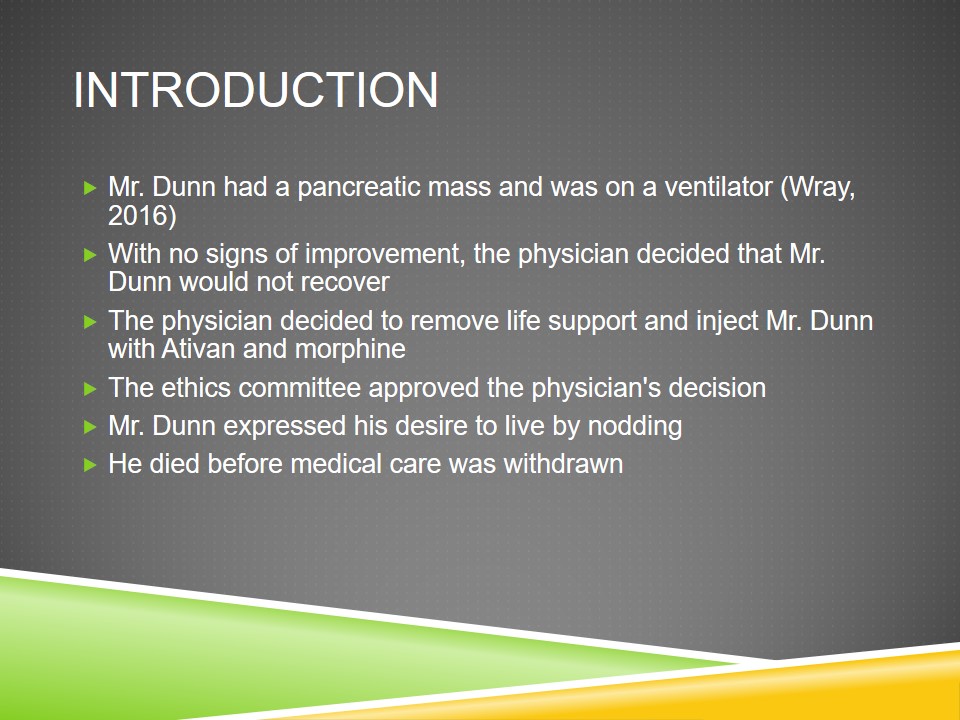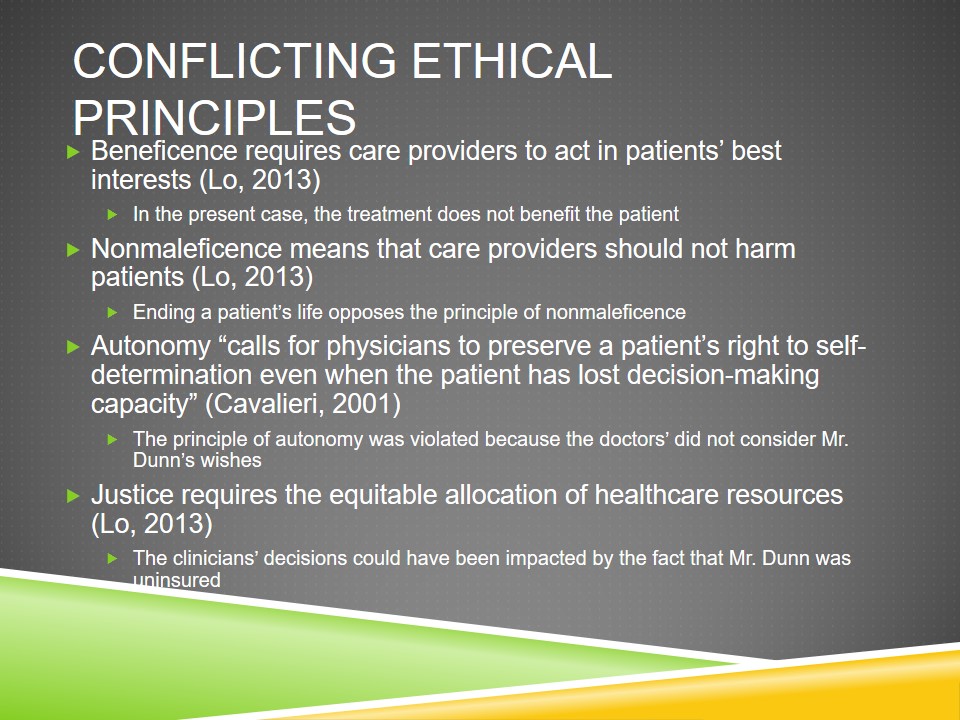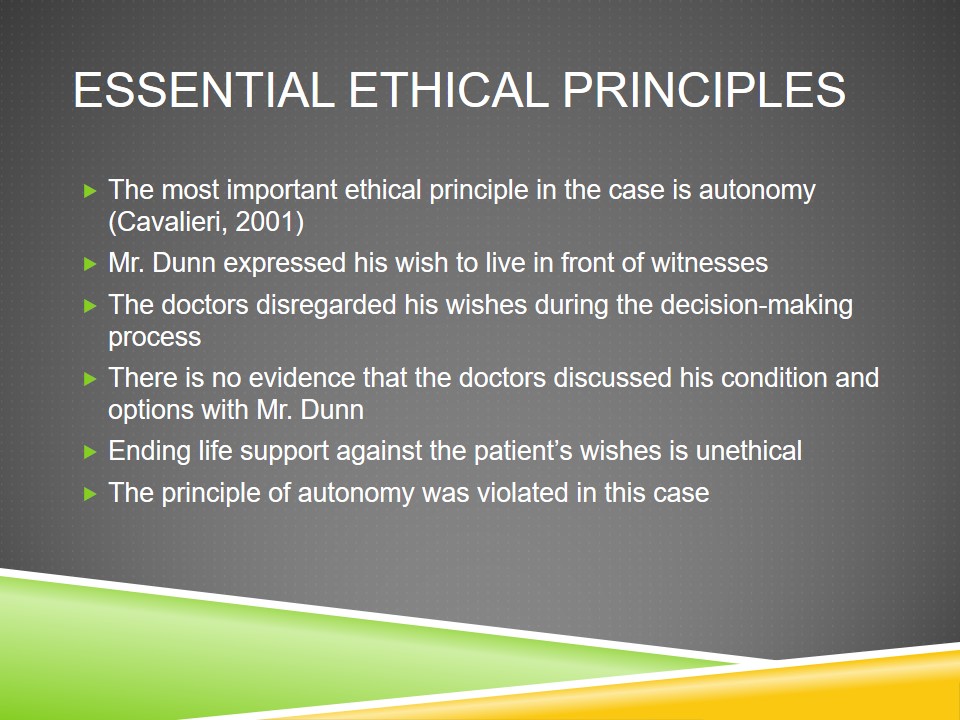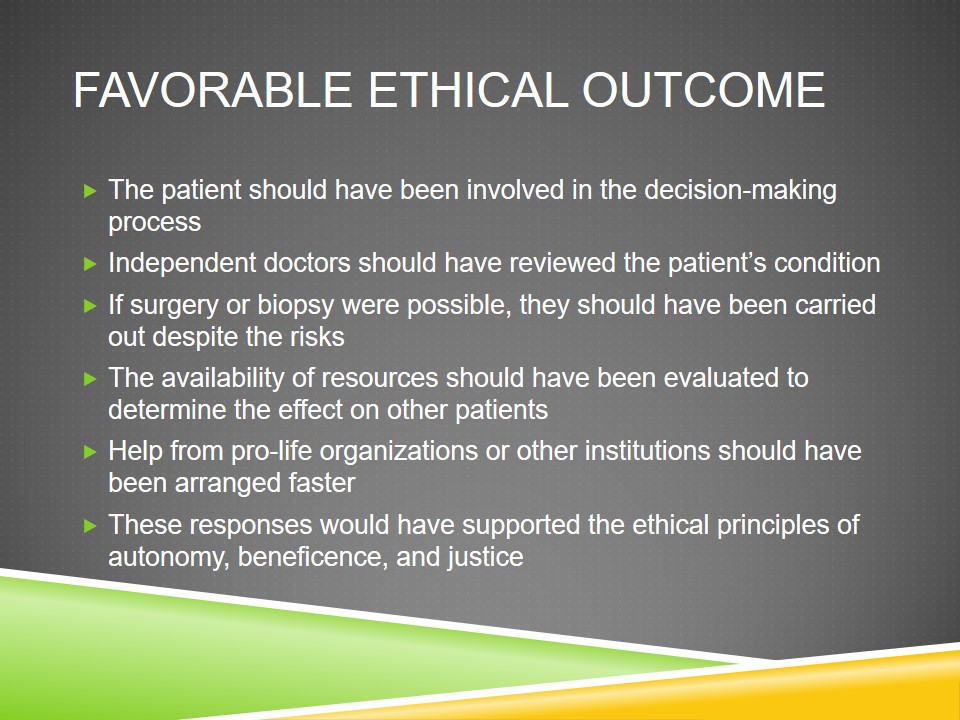Introduction
- Mr. Dunn had a pancreatic mass and was on a ventilator (Wray, 2016).
- With no signs of improvement, the physician decided that Mr. Dunn would not recover.
- The physician decided to remove life support and inject Mr. Dunn with Ativan and morphine.
- The ethics committee approved the physician’s decision.
- Mr. Dunn expressed his desire to live by nodding.
- He died before medical care was withdrawn.
The case study focuses on Mr. Dunn, who had a pancreatic mass and was on a ventilator. His kidneys were failing, and he showed no signs of improvement despite being conscious (Wray, 2016). The physician ruled that Mr. Dunn was too weak to conduct surgery or biopsy, and pushed to take him off life support machines. Mr. Dunn’s mother tried to move him to a different facility, but the patient died before medical care was withdrawn.

Conflicting Ethical Principles
- Beneficence requires care providers to act in patients’ best interests (Lo, 2013);
- In the present case, the treatment does not benefit the patient;
- Nonmaleficence means that care providers should not harm patients (Lo, 2013);
- Ending a patient’s life opposes the principle of nonmaleficence;
- Autonomy “calls for physicians to preserve a patient’s right to self-determination even when the patient has lost decision-making capacity” (Cavalieri, 2001);
- The principle of autonomy was violated because the doctors’ did not consider Mr. Dunn’s wishes;
- Justice requires the equitable allocation of healthcare resources (Lo, 2013);
- The clinicians’ decisions could have been impacted by the fact that Mr. Dunn was uninsured.
The conflicting ethical principles, in this case, are beneficence, nonmaleficence, autonomy, and justice. The principles of beneficence and nonmaleficence require care providers to act in patients’ best interests while avoiding harming them (Lo, 2013). The principle of autonomy means that patients have a right to make decisions regarding their health. In the case, the doctors failed to consider Mr. Dunn’s wishes, thus violating this principle. Finally, the principle of justice means the equitable allocation of healthcare resources and fair treatment of all patients (Lo, 2013). Here, the clinicians’ decisions could have been affected by Mr. Dunn’s lack of insurance, which contradicts the ethical principle of justice.

Arguments Related to Ethical Principles
- Beneficence:
- Care providers should apply treatments that could improve the patient’s condition;
- Nonmaleficence:
- Taking a conscious patient off life support is unethical;
- Autonomy:
- Every person has the right to make decisions about death and dying;
- The patient should approve any treatment or intervention;
- Care providers must take patients’ wishes into account;
- Justice:
- Uninsured persons should experience the same quality of care as insured patients;
- Spending healthcare resources on futile cases affects the availability of care for other people.
Following the principle of beneficence, care providers should use treatments that could improve the patient’s condition. The principle of maleficence means that taking a conscious patient off life support is unethical. To respect patients’ autonomy, care providers must take patients’ wishes into account and let patients make decisions in end of life care. Finally, the principle of justice dictates that uninsured persons should experience the same quality of care as insured patients. However, it also makes spending healthcare resources on futile patients unethical if it means denying treatment to other patients.

Essential Ethical Principles
- The most important ethical principle in the case is autonomy (Cavalieri, 2001).
- Mr. Dunn expressed his wish to live in front of witnesses.
- The doctors disregarded his wishes during the decision-making process.
- There is no evidence that the doctors discussed his condition and options with Mr. Dunn.
- Ending life support against the patient’s wishes is unethical.
- The principle of autonomy was violated in this case.
- Another crucial ethical principle is justice.
- Justice means the equitable allocation of care resources.
- The patient’s uninsured status could have influenced the doctors’ decisions.
- However, spending healthcare resources on futile patients is also unjust.
- People who would benefit from care should be prioritized.
- Applying justice to the case does not provide a certain answer.
The most important ethical principle in end of life care is autonomy (Cavalieri, 2001). In this case, this principle was not followed because Mr. Dunn’s wishes were not taken into account. Violation of patient autonomy makes care providers’ actions unethical.
The principle of justice is also vital in this case. On the one hand, the doctors’ decisions could be influenced by the patient’s uninsured status, thus violating this ethical principle. On the other hand, spending healthcare resources on futile patients can be unjust if they limit care provision to other patients. While people who would benefit from care should be prioritized, it is unclear whether care providers assessed the effect of continuing Mr. Dunn’s care on other patients. Hence, their actions could still violate the ethical principle of justice.


Favorable Ethical Outcome
- The patient should have been involved in the decision-making process.
- Independent doctors should have reviewed the patient’s condition.
- If surgery or biopsy were possible, they should have been carried out despite the risks.
- The availability of resources should have been evaluated to determine the effect on other patients.
- Help from pro-life organizations or other institutions should have been arranged faster.
- These responses would have supported the ethical principles of autonomy, beneficence, and justice.
All in all, the decisions made by the physician and the ethics committee were not in line with the ethical principles of beneficence, nonmaleficence, autonomy, and justice. To achieve a favorable ethical outcome, the care providers should have involved the patient in decision-making. Also, they should have assessed the possibility of performing surgery independently because the physician’s opinion could have been biased. Finally, evaluating the impact of continuing Mr. Dunn’s treatment on other patients was also necessary to achieve a favorable ethical outcome.

References
Campbell, A. V. (2013). Bioethics: The basics. Abingdon, UK: Routledge.
Cavalieri, T. A. (2001). Ethical issues at the end of life. The Journal of the American Osteopathic Association, 101(10), 616-624.
Lo, B. (2013). Resolving ethical dilemmas: A guide for clinicians (5th ed.). Philadelphia, PA: Lippincott, Williams & Wilkins.
Wray, D. (2016). In Texas, a hospital ethics panel – not the patient or family – decides whether to end care. Houston Press. Web.